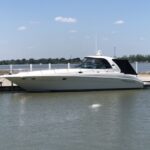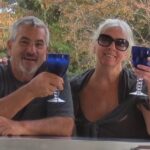Cummins Marine Diesel Repower Specialists › Forums › Cummins Marine Engines › QSM 11 overloaded – how much pitch to take out of the props
- This topic has 9 replies, 4 voices, and was last updated 5 years ago by
Jeremy Gavin.
-
CreatorTopic
-
October 30, 2018 at 6:08 am #39307
2 weeks ago I purchased a 2011 Sea Ray 520 Sedan Bridge (50,000 lb) with twin QSM11s. I am trying to determine how much pitch to take out of the props. I included a pic of the data I took from my run to winter storage. Based on that data if it is enough data to determine, how much pitch should I take out of the props to get the fuel consumption to 20 Gph at 2000 rpm to avoid exhaust issues? The engines both ran up top 2330 rpms at the survey a month ago but I understand from Tony’s tips that this is not importnant but I thought I would share it at least.. The engines have 730 hrs and currently do not have an exhaust leaks. Props are 4 blade federal but they were coated so Dia and pitch are not known.
If more info is needed to make a recommendation please let me know
Thank you for your time.Jeremy Gavin
-
CreatorTopic
-
AuthorReplies
-
November 6, 2018 at 8:27 am #40384
Larry,
The engines had the 1000hr service in May 2017 at around 600hrs by Cummins and at that time aftercoolers, heat exchangers, gear coolers etc where serviced and checked. That was verified by the local Cummins dealer that I hired to do the engine survey. My plan was to get through the coming season and next winter layup to check these items again. Do you think that is a good plan?November 1, 2018 at 5:14 pm #39876Aftercooler !
If you do your own work might as well start by pulling the AC and HX, disassembling them and see what’s going on inside. I learned the hard way onnthe original QSM that came with my boat that engine hours were meaningless compared to Marine age to use Tony’s terms. I thInk I had 500 hrs on the engine when I bought it, but due to a variety of Maine built peculiarities, the engine was first run 5 or 6 years before I got it and corrosion had eaten away at the fins on the AC core as well as both th aC and HX housings.
I’m no propping expert but I think you need to get that 22 GPH at 1930 RPM down into the 19 GPH range.
November 1, 2018 at 10:37 am #39750
Steve LewisParticipantVessel Name: Just Us
Engines: Cummins 480CE
Location: Marblehead, OH
Country: USA
Tony et al.,
My only intent around recommending a call to the factory was to give Jeremy the option to figure out what was on the boat originally from a prop perspective. That may or may not factor into any kind of pitch change method decision he makes for his current Props. Based on his stated numbers at 2030 RPM he has a fair amount of pitch to take out of his props to get rid of excess fuel burn. Replacing his props might be an option and knowing the original spec might be helpful. It is just a phone call away and costs nothing but a few minutes of time.
That might be all for naught as dismounting the props, having them cleaned and scanned will net out the most accurate numbers for pitch and diameter and then ultimately lead to some kind of a decision on how best to back out the pitch. Grind it out or replace the props.
I called Searay before we bought our current boat and we were able to confirm quite a bit of info through comparison and observation based on what they told me. I felt better informed by being able to see what was the same and what had changed.
I apologize for any inaccurate ideas or Red Herrings……..
November 1, 2018 at 5:47 am #39702Larry,
I have seen you go by my dock a bunch of times. I am on the docks just to the left of Flying Bridge between the restaurant and Falmouth Marine. I was on the end of the T right in front of the flying bridge with my other boat a Sea Ray 340 Sundancer “Flipper”. but now we are on one of the long docks. I will look out for you in the spring. I do all my own work on the boat so as anything I can learn about these motors is helpful.Thank you for reaching out.
November 1, 2018 at 5:38 am #39701Thank you for the replies. Sorry my picture with my data didn’t show up on the original post. Here it is below. I don’t have a ton of data as I have only had the boat for 2 weeks but these are the numbers I have on the run home from NY. I am not sure how much it effects these numbers but air cleaners were dirty during this run and fuel although seemed clean it is unknown when the filters were last changed. I have now purchased and installed a set of Tony’s air filters and fuel filters will be changed in the spring but the boat is winterized now so I can’t get more data till the spring.
RPM GPH % throttle % Load Boost
Port 1930 22.1 77 73 26.4
Starboard 1930 21.9 77 72 26.1Port 2030 24.4 82 79 31.9
Starboard 2030 24.3 82 78 30.2Port 2330 33.8 100 98 40
Starboard 2330 33.2 100 97 38.6November 1, 2018 at 3:08 am #39686
Tony AthensModeratorVessel Name: Local Banks
Engines: QSB 6.7 550 HP
Location: Oxnard, CA
Country: USA
Steve,
Every boat is different and when propping any boat, especially one with electronic engine, you have to go by how the engine load is ” as you use it”, and really has nothing to do with how the vessel left the factory years back..
It has taken more than one generation for Cummins Marine Engineers to change their “propping suggestions” as to what they put in print. IMO, they have slowly come around to understand the way this really works in the field after the vessel is put in service and has been well seasoned by one or more owners……
Look at the “Snippet” from their latest power curves.
If you do not understand it, it goes like this:
In neutral ( NO-Load) , all of these “Q” engine have a “governor speed” that is set by the ECM. In the case of a “2300 RPM rated” QSM11, it’s typically right at 2360-2670 or so… Just check it when the engine is warm, and write in down in the log book……………………..Then, when you are running the boat, when at exactly rated RPM “2300” in this case, your load should AT 92%-95%..
As I said, they are slowing coming around ..
Listen to Larry B.. He’s been there and done that. Prop to the fuel fuel or below at the CRUISE SPEED/RPM you travel at, & don’t worry about WOT other than working what Cummins is trying to say into the overall equation……..Maybe one could simply summarize the Cummins statement as saying, just “leave 5-8% ” on the table ??……………..
Tony
November 1, 2018 at 3:04 am #39684
Tony AthensModeratorVessel Name: Local Banks
Engines: QSB 6.7 550 HP
Location: Oxnard, CA
Country: USA
Steve,
Every boat is different and when propping any boat, especially one with electronic engine, you have to go by how the engine load is ” as you use it”, and really has nothing to do with how the vessel left the factory years back..
It has taken more than one generation for Cummins Marine Engineers to change their “propping suggestions” as to what they put in print. IMO, they have slowly come around to understand the way this really works in the field after the vessel is put in service and has been well seasoned by one or more owners……
Look at the “Snippet” from their latest power curves.
If you do not understand it, it goes like this:
In neutral ( NO-Load) , all of these “Q” engine have a “governor speed” that is set by the ECM. In the case of a “2300 RPM rated” QSM11, it’s typically right at 2360-2670 or so… Just check it when the engine is warm, and write in down in the log book……………………..Then, when you are running the boat, when at exactly rated RPM “2300” in this case, your load should AT 92%-95%..
As I said, they are slowing coming around ..
Listen to Larry B.. He’s been there and done that. Prop to the fuel fuel or below at the CRUISE SPEED/RPM you travel at, & don’t worry about WOT other than working what Cummins is trying to say into the overall equation..
Tony
October 31, 2018 at 1:11 pm #39624
Steve LewisParticipantVessel Name: Just Us
Engines: Cummins 480CE
Location: Marblehead, OH
Country: USA
Jeremy,
One of things you will want to do is call Searay Customer support and give them your hull number. They will tell you what transmissions and ratios you have and the props that shipped from the factory. They will give you Diameter and Pitch. Those are going to be good things to know. I do not see the “pic” you mention so we will not be able to lend a hand on how overloaded the engines are. You may just want to post the numbers for fuel burn from 1800 – 2100 as that will encompass your cruise RPM range and yes you will want to prop down to the 20GPH as you stated. With out current fuel burn numbers we can not help.
Here is Searay’s main number then you need to listen to the prompts to find customer support for yachts.
Phone +1 (865) 582-2200
I have a 2006 40 Sundancer and they were very helpful with letting me know what shipped from the factory.
October 30, 2018 at 6:42 pm #39436Falmouth QSM
Come find me at East Marine and we can talk all things QSM. Got a 670 propped down to 94% load and 31 GPH at WOT in my downeast, took 3-4 years to get it propped correctly, with a lot of advice from Tony.
In simple terms in addition to being able to hit 2350 and not be at 100% load, you really want to be close to or below the prop curve at whatever RPM you run the boat at to cruise.
I cruise at 1875 RPMs and am at 17.5 GPH moderate load, 18.5 GPH full canyon load and have the bulk of my data points at or below the QSM prop curve. I stay away from my bad spots on the curve which is roughly 1500-1750 RPM where I am in the hole and above the prop p curve.
-
AuthorReplies
You must be logged in to reply to this topic.
